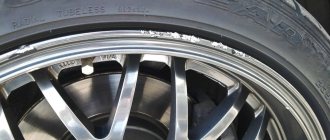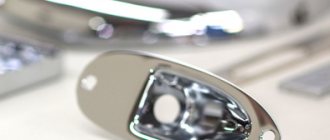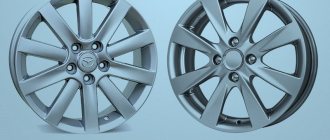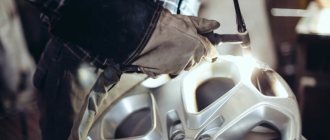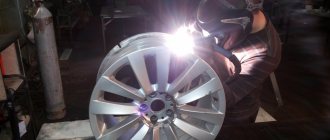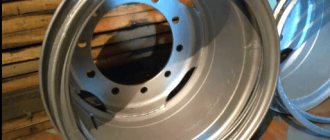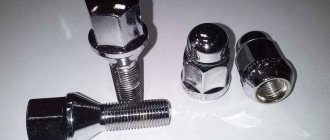Chrome plating of car wheels is one of the options for modifying and tuning it, allowing you to give it individuality. This procedure involves applying a layer of chromium to the surface of car wheels - a fairly inexpensive material that, however, has excellent protective characteristics. In addition, chrome wheels, with their exceptional decorative properties, look equally good on almost any vehicle.
You can buy luxury wheels, but it’s cheaper to update old ones by covering them with chrome using one of the available technologies
Technological features of the process and options for its implementation
With the help of chrome plating, not only the rims of a car can be processed, but also its body elements, handles and other parts. At the same time, they are covered with a protective layer of a beautiful silver color with a golden tint. This technology for decorative and protective processing of alloy wheels and other car parts has been actively used in many countries for many years.
Chrome plating, as mentioned above, not only makes the product more attractive, but also reliably protects it from the negative effects of the external environment. In particular, chrome plating of car wheels will provide them with reliable protection from corrosion, mechanical damage and the negative effects of various chemicals. The outer surface of car wheels that have undergone chrome plating is more resistant to chips and scratches.
Disc before and after chrome plating
You can chrome rims and other car parts in a variety of ways. Let's look at the most popular of them.
Galvanic method
This method involves a fairly long treatment, during which a layer of metal is applied to the product as a result of electrochemical processes. In this case, the adhesion of the applied metal to the surface being treated is ensured by intermolecular bonds, which makes the finished coating as reliable as possible.
Chromium plating, performed by galvanic method, although it is an expensive procedure, allows you to apply a layer of chromium to the surface of alloy wheels, providing them with reliable protection not only from corrosion, but also from mechanical damage. You can do galvanic chrome plating of car wheels yourself, but to do this you will have to prepare the appropriate equipment and purchase chemical reagents for the electrolytic solution.
The main problem with self-galvanic chrome plating is that processing discs will require a large capacity and, as a result, a large consumption of electrolyte
Chemical method
Unlike electroplating, in this case hydrochloric acid is not used; the chromium-containing reagent undergoes a process of dissolution in distilled water. During the chemical reaction, chromium is released, which is deposited on the surface of the workpiece.
This method of chrome plating is much simpler than electroplating and can be easily implemented on your own at home. However, we should not forget that incorrect work with chemical reagents is fraught with very serious consequences for health.
In the video below you can familiarize yourself with the principle and nuances of this metallization technology.
Application of special coatings
Such paint and varnish coatings contain a significant amount of chromium, which determines their protective properties. Applying these coatings to the surface of cast wheels is much cheaper than performing galvanic chrome plating, but the protective layer they form is also significantly less reliable. This method is the most popular when chrome plating wheels yourself.
Chrome paint comes in cans (one-component) or cans (two-component). The latter provides a more wear-resistant coating
Diffusion technology
In production conditions, chrome plating can be performed using diffusion technology. In this case, the disc to be treated and the chromium-containing composition are placed in an oven, where they are heated to a high temperature. As a result, the chromium-containing composition goes into a vapor state, and chromium molecules penetrate into the surface layer of the workpiece.
Drying wheels after chrome plating
Hot method
When performing chrome plating using hot technology, the disc is placed in a bath of molten chromium, which forms a protective layer on its surface.
The last two processing methods require the use of rather complex production equipment, as well as the creation of certain technological conditions, so it is problematic to implement them privately.
What will you need for work?
To carry out galvanic chrome plating of parts at home, you need the following materials and equipment:
- spacious glass container;
- tubular type electric heater;
- mineral wool;
- non-metallic container (for example, a basin);
- wooden box;
- several durable wire clamps;
- fiberglass;
- plate or rod anode.
A wooden box is used to create a base, similar to a large thermos, after which it is covered with fiberglass and filled with mineral wool and sand to form a thermal insulation layer. The clamps act as a cathode, they are connected to the negative, the glass container is placed in a basin - then the anode is secured.
Restoring chromium at home involves making your own electrolyte. To do this, you need to mix sulfuric acid and diluted chrome anhydride in the required proportion (for example, 2.5 g of H2SO4 per 250 g of chrome anhydride).
To make really high-quality chrome plating, a liter of distilled water heated to 60 degrees is poured into a glass container, anhydrite is added, then acid. After the solution is ready to restore the coating of the discs, a current is passed through the liquid (until a red-burgundy tint appears).
Advantages of using chrome plating for wheels
Among the most significant advantages that rims coated with a protective layer of chrome have, the following should be highlighted.
- Chrome plating improves the heat transfer characteristics of the disks, which significantly increases their service life.
- The surface of chrome-plated rims is highly durable and less susceptible to mechanical damage such as chips, scratches and dents.
- The coating applied to the surface of the wheel rims using chrome plating reliably protects them from the negative effects of moisture, dirt, and chemicals. Considering the fact that car wheel rims are constantly under the influence of such negative factors, applying chrome to their surface is a fairly relevant procedure.
Surface preparation
The better the surface of the product is prepared, the fewer problems will arise during galvanic chrome plating and the better the quality of the coating.
- Preliminary mechanical and chemical cleaning. Heavy contaminants (varnish, paint, rust stains) are removed. Rust from the metal surface can be removed by etching in acid, and paint residues can be removed with sandpaper.
- Fine cleaning. Traces of dirt are carefully removed with a clean piece of cloth.
- Degreasing. The procedure requires a solution of 150 g of sodium hydroxide, 50 g of soda ash and 5 g of silicate glue (calculated per 1 liter of water). The item is kept in the solution for 20-60 minutes at 90° C; time is affected by the complexity of the form.
How to care for chrome wheels
It is important to know not only how to chrome car wheels, but also how to care for the coating applied to them, which, despite its reliability, requires constant attention.
To remove heavy dirt, use special products for chrome surfaces.
In order to maintain the appearance of chrome wheels and the protective characteristics of their coating in their original condition for a long time, you should follow a few simple recommendations.
- If no serious damage is found on chrome-plated discs, then caring for them consists of regular cleaning, performed once every one or two weeks. This cleaning is carried out using a piece of soft cloth and a detergent that should not contain chemicals that can damage the chrome plating (acetone and ammonia). After cleaning with detergent, the disc is rinsed with plenty of running water. To give the coating its original mirror shine, after washing and drying, you can use special polishing compounds.
- If minor defects appear on a chrome plated disc, the problem areas must first be cleaned using a regular napkin and chalk crushed to dust. After treating the damaged areas with chalk powder, a layer of colorless varnish should be applied to them. Such an additional protective layer will preserve the oxide film formed on the metal product during the chrome plating process and will protect the disc from further destruction of the chrome layer.
- Chrome coatings, if we talk about their disadvantages (of which there are not many), are quickly covered with dust and dirt, so they need to be washed more often than other elements of the vehicle. To do this, it is best to use warm water, supplying it under low pressure so as not to damage the protective layer.
- Dried dirt, if it appears on a chrome surface, cannot be removed immediately: the protective layer can be damaged and scratches and abrasions may appear on it. First, dried dirt must be soaked and after some time removed with a soft cloth.
- Plaque that remains on the surface of the chrome disc after washing and cleaning is best removed with a damp sponge. After cleaning with a damp sponge, the disc should be thoroughly rinsed with water and wiped with a clean soft cloth.
- The cleaning procedure should be performed on both sides of the wheel - outer and inner. During operation, dust and dirt get clogged into all the bends and recesses of the wheel rim, so it is important to thoroughly clean its entire surface using warm water and a sponge. There are many products available on the market today to effectively clean chrome wheels.
- If a chrome wheel needs thorough cleaning and restoration of the damaged coating, it is necessary not only to remove it from the car, but also to free it from the tire. Only by doing this will you be able to process your car rim even in hard-to-reach places.
If you follow all of the above recommendations and carefully monitor the condition of your car’s chrome rims, you can maintain their attractive appearance for a long time.
Chromium restoration procedure
Restoring chrome parts is a much more complex procedure than restoring painted products to their original appearance. A damaged chrome layer can only be properly restored using special equipment and consumables, many of which cannot be purchased at a regular hardware store.
Therefore, in cases where a chrome car wheel or other chrome-plated car element needs to be restored, it is best to contact specialists. However, knowing how to restore chrome plating to give it its original attractiveness and protective properties will be useful for any car enthusiast.
Throughout the entire existence of metal parts created by people, humanity has strived in every possible way to improve the appearance of the parts.
For this, various technologies relevant for their time were used. But a little more than a hundred years ago, humanity began to actively use electroplating to coat metal products with protective and decorative layers of metals.
Among the most commonly used metal coatings are zinc and chromium. The remaining metals are either too expensive for mass use or do not have the same positive properties as these metals.
Unusual Effects
Thermochromic materials have earned the name “chameleon paints” due to their special qualities. Such coatings can change their appearance under the influence of temperature changes, for example:
- initially colored paint becomes invisible;
- when the temperature is heated or lowered, colorless paint takes on a certain shade;
- Due to changes in ambient temperature, the coating may change color completely.
There are compounds that can produce any of these effects every time the coating is exposed to heat or cooled, and some are designed for a single “reincarnation”. They are called, respectively, reversible and irreversible.
There are materials on sale that, when painted in chrome, give the coating a matte finish. When producing such paints, a special component is added to the composition to reduce the reflective potential of the coating. This paint is used to chrome plumbing fixtures, furniture fittings and much more. Matte chrome looks strict and elegant.
Possible defects and their causes
- Chrome does not settle on the workpiece. The reason may be poor contact, a film of oxides, or a small distance between the electrodes. The process is disrupted due to incorrectly selected conductor cross-sections, excess sulfuric acid, low current density or too hot electrolyte.
- The surface shine is absent or uneven (with darkening and spots). The temperature regime of the electrolyte and the concentration of the reagents are not observed. The current has been exceeded.
- There are growths of metallic chromium on the corners of the object. Current density is higher than recommended.
- Defects (sinks) on chrome plating. Poor cleaning. Excess current, hydrogen retention.
- Peeling of coating. Poor degreasing, surges in voltage, current density or temperature.
Decorating plastic with a layer of chrome in a home workshop is no more difficult than metal. The key to a brilliant result will be thorough compliance with safety rules and attention to the details of the technological process.
